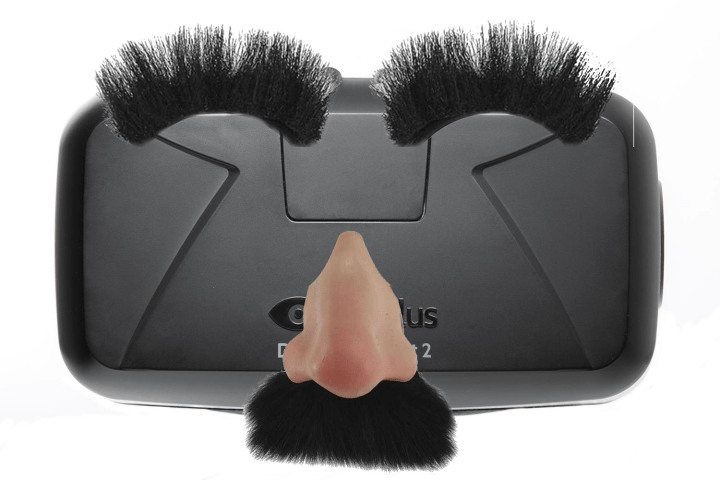
Many people are overcome by vertigo and nausea after just a few minutes of exploring virtual worlds, despite recent advances in motion accuracy and lag reduction. Indeed, mitigating motion sickness is one of the biggest challenges currently facing VR engineers. Purdue scientists have found one potential solution, hiding right in front of us all along: a nose.
Motion sickness is generally caused by a disparity between what you see and what you feel. When you’re a passenger in a moving car, for example, your inner ear senses movement, but with the car’s static interior filling most of your vision, your eyes tell your brain that you’re standing still. Our bodies don’t like to be confused like that, and that dissonance results in nausea.
Games with fixed visual reference points, such as a spaceship’s cockpit, have been anecdotally shown to reduce simulator sickness. “But you can’t have a cockpit in every VR simulation,” explained David Whittinghill, an assistant professor of Computer Graphics Technology at Purdue University. Whittinghill’s research team was tackling the problem of simulator sickness, when undergraduate Bradley Ziegler suggested inserting a virtual nose into the visual field.
“It was a stroke of genius,” said Whittinghill. “You are constantly seeing your own nose. You tune it out, but it’s still there, perhaps giving you a frame of reference to help ground you.”
In a study presented earlier this year at Game Developers Conference, Whittinghill’s team found that the virtual nose, or “nasum virtualis,” consistently reduces simulator sickness for most people. Forty-one test subjects used numerous VR applications with varying levels of motion intensity. Subjects in the languid Tuscan Villa simulation were able to play an average of 94.2 seconds longer before feeling any signs of sickness. Subjects in a roller coaster simulation could go for another 2.2 seconds on average.
Researchers relied on both self-reporting and electro-dermal activity sensors (which measure skin conductivity) to gauge when sickness strikes. The delay of when nausea sets in was consistent across both measures.
“The roller coaster demo is short, but it’s very intense at times, spinning upside down, jumping across chasms, plunging fully vertical, so people can’t do it very long under the best of circumstances,” Whittinghill said. “We had a reliable increase of 2 seconds, and it was a very clear trend. For the Tuscany demo it takes more time, but eventually you start getting queasy, and 94 seconds is a huge improvement.”
Perhaps the most fascinating part of the study is that most subjects, who were not told about the experiment’s parameters beforehand, didn’t even notice that the nose was there at all. “Surprisingly, subjects did not notice the nasum virtualis while they were playing the games, and they were incredulous when its presence was revealed to them later in debriefings.”
Research is still ongoing, because they do not yet have a firm theory on why the nasum virtualis works. “Our suspicion is that you have this stable object that your body is accustomed to tuning out, but it’s still there and your sensory system knows it,” speculated Whittinghill. “Our long-term goal is to create a fully predictive model of simulator sickness that will allow us to predict, given a specific set of perceptual and individual inputs, what level of simulator sickness one can expect.”
Another approach to solving the simulator sickness problem is to just provide physical motion to match what’s happening in the simulation. Roto is a motorized chair platform currently on Kickstarter, designed to match in-game movement with physical motion, creating greater immersion and mitigating nausea. Alternatively, HTC and Valve’s recently revealed system side-steps the issue entirely by limiting your movement to an actual, physical space, removing the experiential dissonance.
Editors' Recommendations
- If you want a Quest 2, buy one before it gets a big price hike next week
- This futuristic haptic vest should make virtual reality feel more realistic
- Pimax’s 12K QLED VR headset wants to take virtual reality to the next level
- Apple’s mixed reality headset could be half the weight of other headsets
- The Future of Vision: Augmented reality contact lenses will make you bionic


